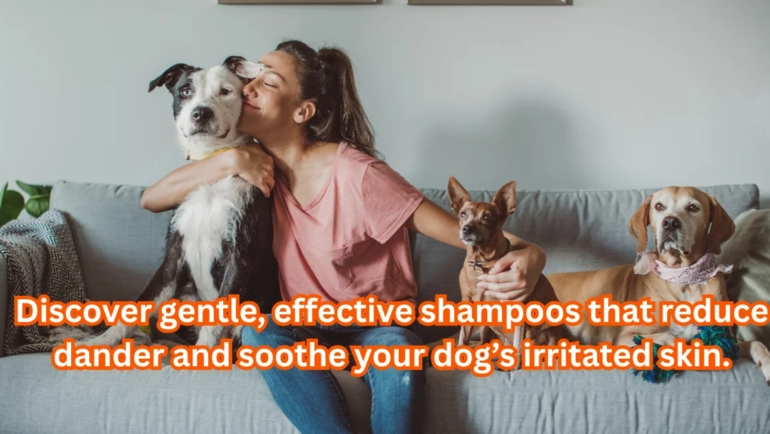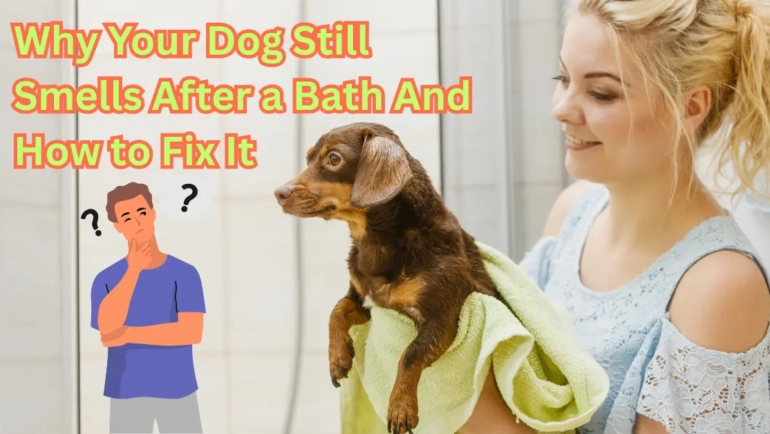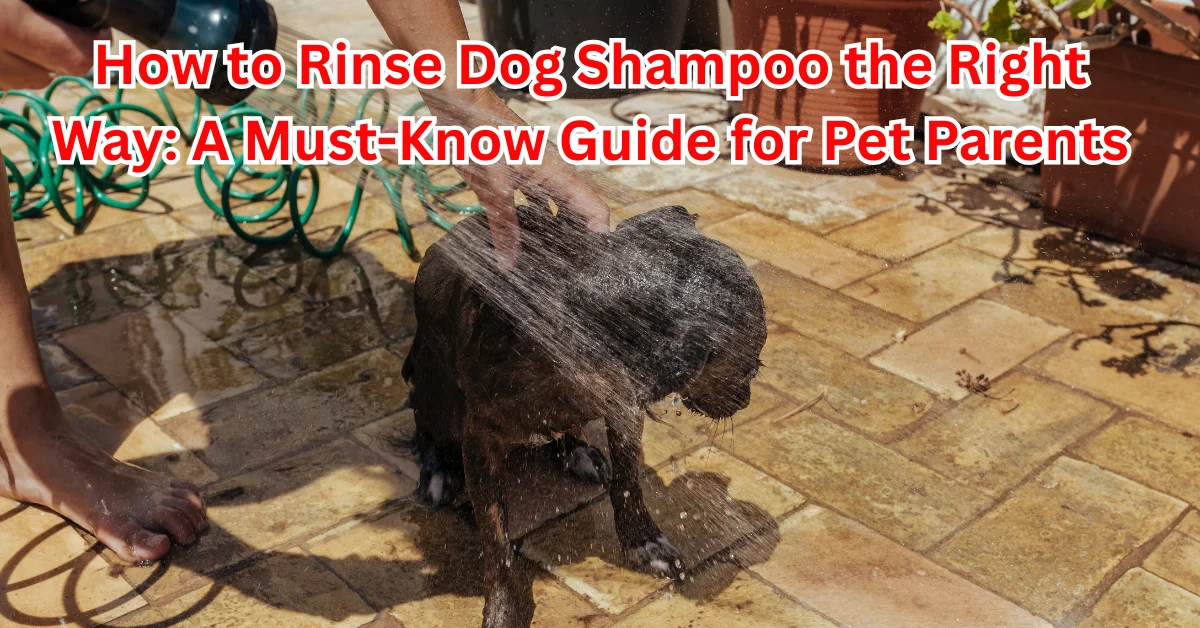
Avoid Itchy Skin: Proper Dog Shampoo Rinsing Tips
Have you ever bathed your dog, only for it to scratch like crazy afterward? What’s annoying is that what you’re trying to do to them is somehow backfiring. At that point, I, too, asked myself if I had missed a step. I learned that rinsing is more than “splash and go.” It’s one of the most important parts of the whole process. If you still have shampoo on your skin, it might itch, turn red, or hurt in places. There are some easy steps you can take to make bath time safe and comfortable for your pet friends. This guide will show you how to rinse your dog’s fur properly and what to look out for. Plus skin that’s happy and tails that wag!
Is Dog Shampoo Irritating to the Skin?

It most certainly can. If you don’t wash the dog shampoo out well, it could also hurt the skin. Even light shampoos can leave a film that dries out your dog’s skin, causing it to itch or turn red. There are also strong ingredients in other shampoos that don’t work well with sensitive skin. Instead, your dog may be scratching because of shampoo that is still on his fur after a bath.
There are ingredients in the learning that are harsh on the dog’s skin. The use of artificial fragrances, sulfates, dyes, and parabens tends to complicate things. The chemicals can strip natural oils, leaving skin dry, flaky, and, worst of all, allergic. The dogs most likely to get hurt are those with sensitive skin or certain breeds, such as Boxers, Bulldogs, or Retrievers.
This takes place with my dog Rumi. While she usually calms down after a bath, there was one time she kept scratching and seemed antsy for hours. At first, I thought it might be bugs or a new allergy. But by the time I got to the register, I realized I hadn’t rinsed her well enough. Shampoo had gotten stuck under her thick fur, especially on her neck. The next day, her face looked a little red, and I felt terrible. Thank goodness she hasn’t had any problems since I switched to a softer shampoo and started giving her more time to rinse.
I keep forgetting to rinse, which teaches me a lot. That’s not the fizzy jack of the bath. It’s important not to leave anything behind. Within the next part, I will go into more depth about the ingredients you should avoid and how to spot irritation early, before it gets worse.
What will come up in case you do not get rid of all the shampoo?
You shouldn’t leave shampoo on your dog’s skin because it could make them very sick. It only takes a little to build up and cause dryness, redness, and constant itching. Your dog’s fur may look clean, but the ingredients still on its skin are making it sick.
The Problems with Shampoo Residue
Shampoo that stays on the skin acts like a chemical irritant. It strips your dog’s skin of the natural oils that keep it healthy. This could cause your dog’s skin to peel, turn red, and feel so itchy that even their wildest dreams can’t explain it. If the dog licks and pokes at the spot all the time to bother it, this could get worse. If you don’t treat it, it could lead to painful hot spots or even skin diseases.
One day I remember trying to bathe my dog Rumi, and things did not go according to plan. I was in a hurry, so I’m not sure if I rinsed her well enough. She was fine in the morning, but that night in bed, I could feel her scratching her chest over and over. When she woke up the next morning, there was a red, dry, and itchy spot where she had been scratching. I was awful. Even though I tried to make her feel clean and fresh, I forgot one little thing.
Today I have made rinsing most significant during bathing. I even rub my fingers through her coat during the rinse, making sure no slippery or soapy feel is left behind. It adds a couple of minutes, but leaves her happy and comfortable afterword.
Do I Dilute Dog Shampoo?
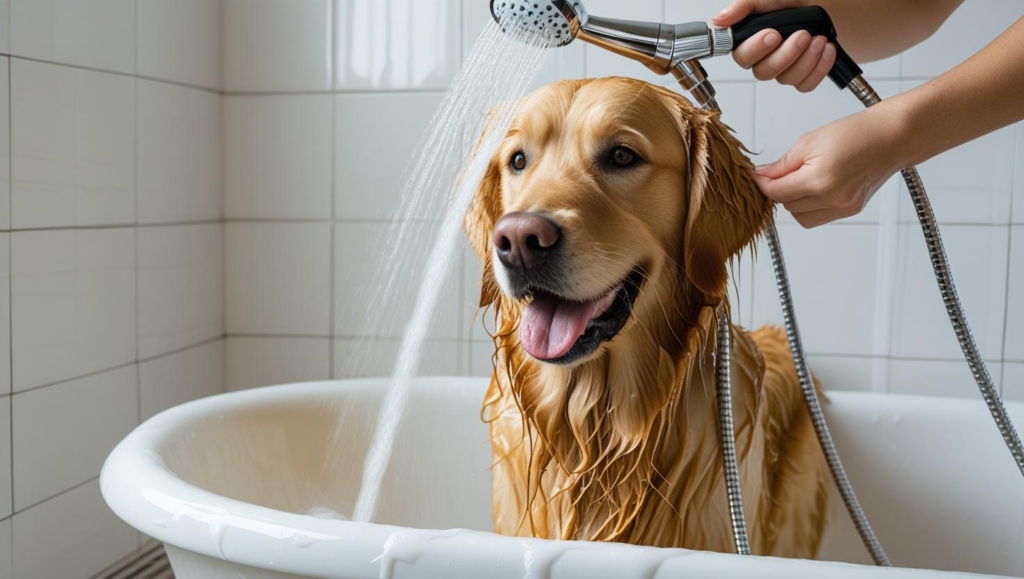
Watering down of dog shampoo may indeed be useful. It ensures that it spreads and rinses easily on the thick or the double-coated dog. It also reduces the risk of your dog’s skin being irritated by the strong ingredients.
The Benefits of Diluted Shampoo
You can make the shampoo lighter and less dense by adding water. This means it won’t hurt your dog’s skin as much and will be easy to wash off. Shampoos that are too thick might get into the fur and be hard to get out. If you leave any of it behind, it will dry out or itch later.
Once my dog Rumi started getting itchy when she came into contact with shampoo residue, I started diluting the shampoo. At the moment, I put some shampoo and warm water in a small plastic bottle and shake them together before using them. It helps me spread the shampoo evenly over her body, especially where she has more fur, such as around her neck and below her belly. I now know that she feels calmer after a bath, and I’m no longer scared because I know her skin is clean and healthy.
Watch out for putting too much water in. It won’t be possible to clean well with shampoo if it gets weak. If it doesn’t say otherwise, use it in a 1:1 ratio or as directed on the box.
Here are the steps you need to follow to make sure you rinse your dog’s coat thoroughly, without missing any spots.
How does an Allergy Shampoo Reaction to Dogs appear?
An allergy usually shows up as itching, redness, or swelling. If you are allergic to dog shampoo, these symptoms would happen. These responses could happen right away, like after taking a bath, or they could take a day or two to show up. It can be hard to tell what the signs are at first, but this can quickly become worse for your dog.
Symptoms That May Be Observed
Take note of some red spots on the skin, having continuous scratching or your dog liking of particular spots. If there is growth, especially around the eyes, ears, or paws, it may also be a clear sign. Some dogs might even develop small bumps or lose fur in the area where the response is occurring.
I remember seeing Rumi shake her head and rub her ears for a few hours after taking a bath. I didn’t think much of it at the time. The next morning, though, she found that her right ear had swollen and turned red. The shampoo I had not used before turned out to be the one that helped her. I stopped using it right away and switched to a simple oatmeal mix. After a few days, this redness appeared, and thankfully, she wasn’t as happy as usual.
If any of these things happen while you’re bathing your dog, you should stop using shampoo right away. It would be smart to take the pet to the vet in case the pain or swelling doesn’t go away. Next, I’ll show you how to safely rinse off dog shampoo so that you don’t have to deal with these reactions in the first place.
Rinse dog shampoo step-by-step
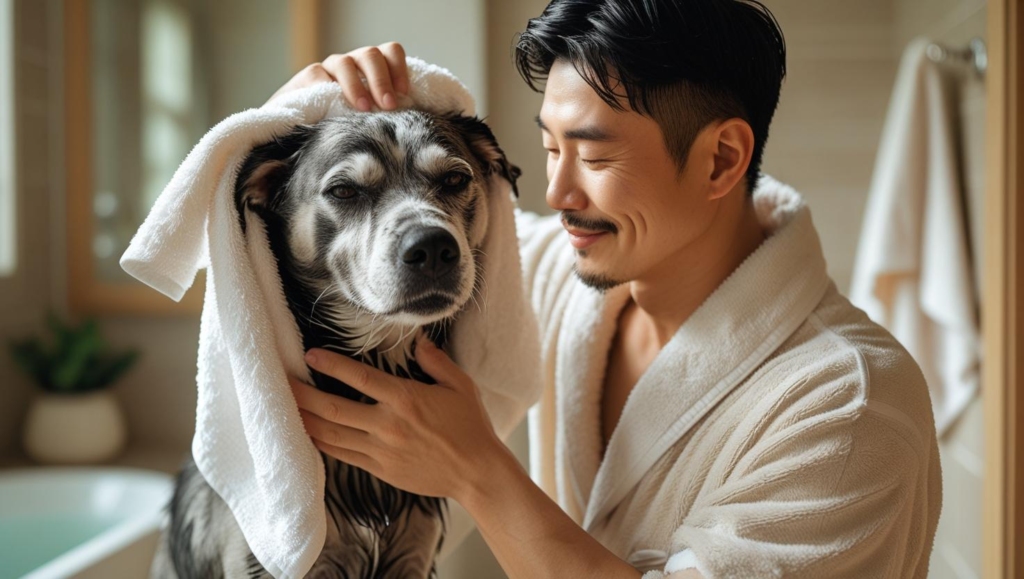
Rinsing off dog shampoo properly is probably the most important part of bath time. Anyone who leaves any of them behind could make your skin itch, feel dry, or irritate it. Even with the best shampoo, problems can still occur. Your dog’s skin stays healthy and clean after a good rinse.
The Right Water Temperature is a Place to Start
Only use warm water. Cold water is not good for your dog. Their skin might get dry or burn in hot water. Water that is warm or cool is safe and looks good. She would tighten up when I put in cooler water. That changed when she switched to lukewarm. Now she doesn’t get stressed during the rinse break.
Neck to Tail Work
Start rinsing at the neck and proceed gradually to the tail. This allows them to avoid running the shampoo into their eyes or ears. Handle the head a little more tenderly. I would mostly wipe the face of Rumi using my hand, or a wet cloth, rather than spraying the water close to her ears.
Wash in your own sweet time
Wash well for 3 to 5 minutes. Do not rush. As you rinse, run your hands through the fur to make sure there aren’t any soapy or slippery places. Rinse repeatedly until the water is clear. Rumi has a medium-length coat, so I usually clean her for longer than I think she needs. In the future, I would use an extra minute to see her weirdly.
Look at the Feel of the Coat
Feel the coat after you wash it. Is it still soft or slinky? Then you might not have removed the shampoo yet. For dogs with thick or double coats, you need to rinse them more thoroughly. I did that wrong when I took a bath one winter. Even though Rumi’s hair was a clear color, I saw her scratching her belly the next day. Before I finish, I make two and two of how her coat feels.
Repeat where necessary
There’s no reason not to rinse your dog again, especially if the shampoo is too thick or the dog was very dirty. For better cleaning, do a second rinse. She should be ready instead of having itchy skin. Rumi got muddy after a walk in the rain, and I had to rinse her hair twice before all the shampoo was gone. After that, she was very happy.
Easy after-Bath Care of Happy Skin
After the bath, use a soft towel to dry your dog gently. Do not rub too much. That can annoy the skin or cause a slip-up in the coat. Rumi cherishes the towel part. I believe she regards it as a comfortable way to end her bath time.
It is also possible to apply a leave-in conditioner or a moisture spray that is dog-safe. The products help calm the skin and add a little extra softness to the coat. Sometimes I spray Rumi with a light oatmeal spray, particularly during these dry winter weeks.
Observe your dog in the next 24 to 48 hours. This could be a response if you notice itching, redness, or changes in your behavior. It doesn’t always happen right away. Also, brush your pet often after a bath to spread the natural oils and keep the hair healthy and smooth.
Think about it this way: Keep It Clean and Safe. You should do more than use dog shampoo to properly clean your dog. In other words, they should take care of their skin, not hurt it, and enjoy a safe, fun bath. We talked about why it’s important, what to do, and what to watch out for after a bath.
Everyone who has a dog wants their four-legged friend to be healthy and happy. I’ve learned that giving Rumi a couple of extra minutes of rinsing can make a big difference. You can do the same thing for your dog. You’ll go slowly and rinse your hair the next time you wash, thinking that this will keep your movie partner healthy and happy.
FAQ About Proper Dog Shampoo Rinsing Tips – Avoid Skin Issues
How often should I bathe my dog?
Most dogs only need a bath every 4–6 weeks unless they get dirty or have skin issues. Overbathing can dry out their skin.
Can I use baby shampoo on my dog?
Baby shampoo is gentler than regular human shampoo, but it’s still not ideal. Use a vet-approved dog shampoo for safest results.
What if my dog hates baths?
Use treats, calm tones, and slow introductions to water. Try a handheld sprayer or a lick mat with peanut butter to distract and comfort.
How do I bathe a puppy safely?
Use lukewarm water and a puppy-safe shampoo. Avoid eyes and ears. Dry them well and keep the session short and positive.
Is dry shampoo safe for dogs?
Occasionally, yes. But it should never replace proper baths. Avoid products with alcohol or strong fragrances.
Should I brush my dog before or after a bath?
Both. Brushing before removes tangles and loose fur. Brushing after helps redistribute oils and prevents matting.
What if my dog licks the shampoo?
Rinse quickly and thoroughly. Most shampoos are non-toxic in small amounts, but check the label and call your vet if needed.
How do I bathe a dog with skin allergies?
Use a hypoallergenic or medicated shampoo recommended by your vet. Rinse extra thoroughly and avoid fragrances.
Can I bathe my dog outside?
Yes, if the weather is warm and water is safe. Make sure to dry them fully and avoid cold air exposure.
What’s the best way to dry my dog after a bath?
Pat with a towel, then use a pet dryer on low heat if needed. Avoid human hairdryers, which can overheat and hurt your dog’s skin.


